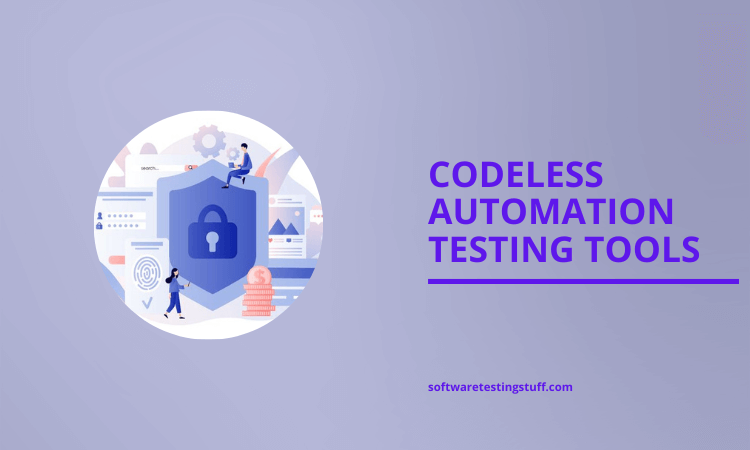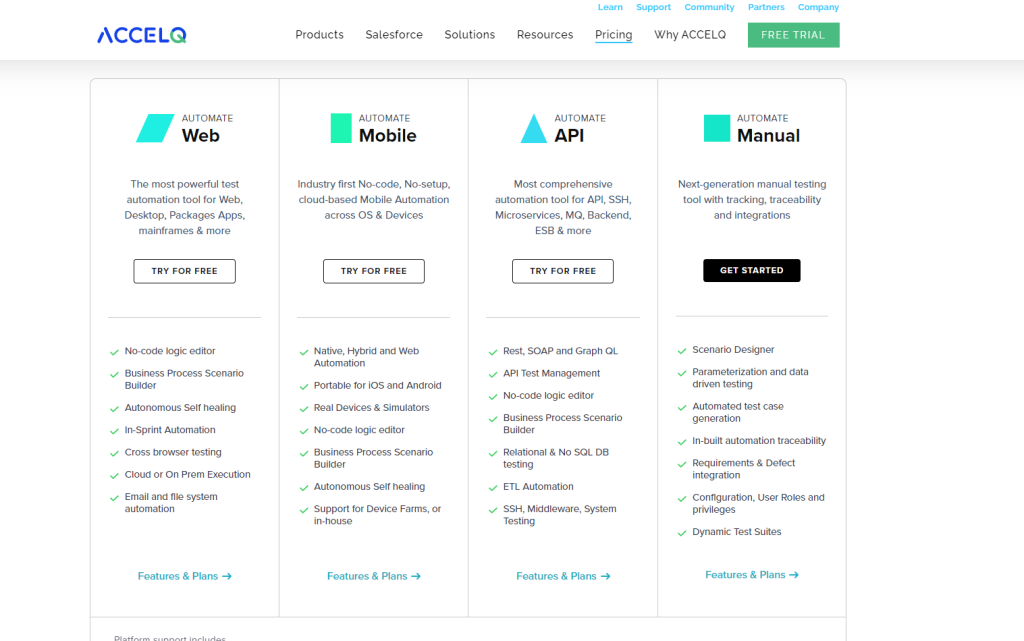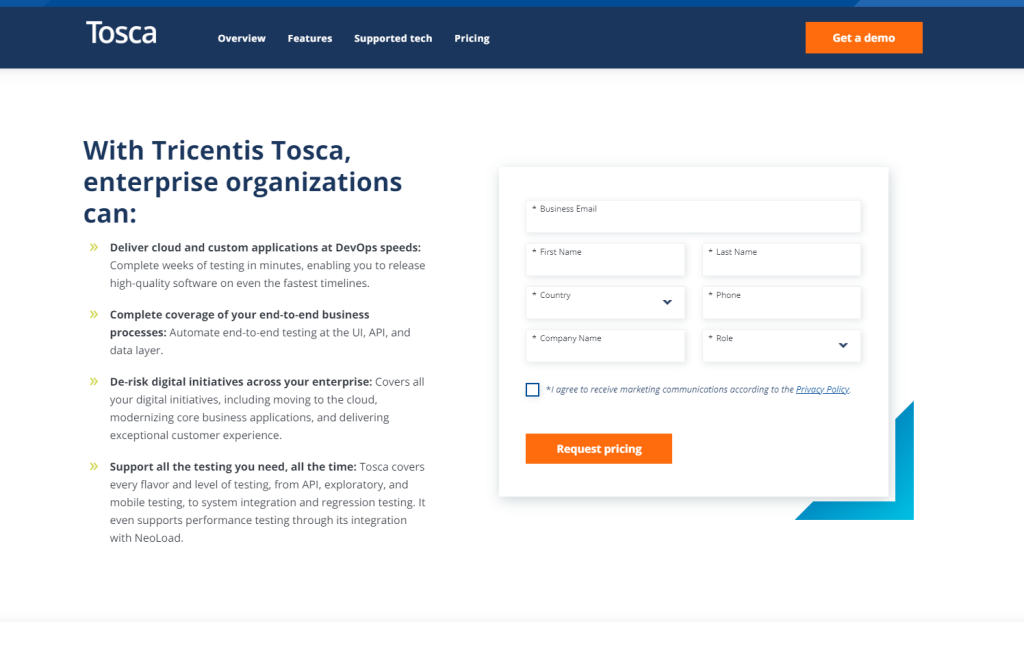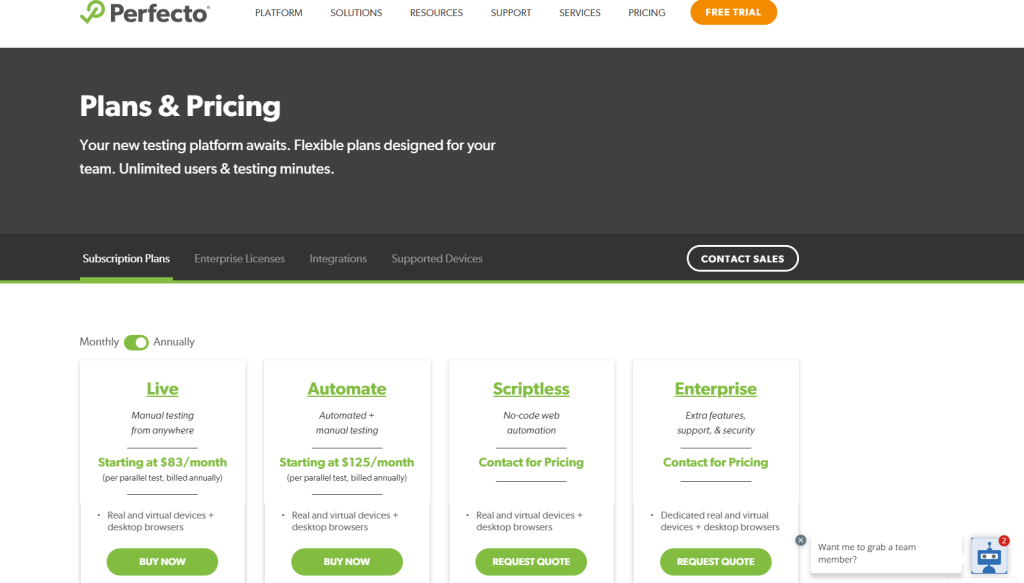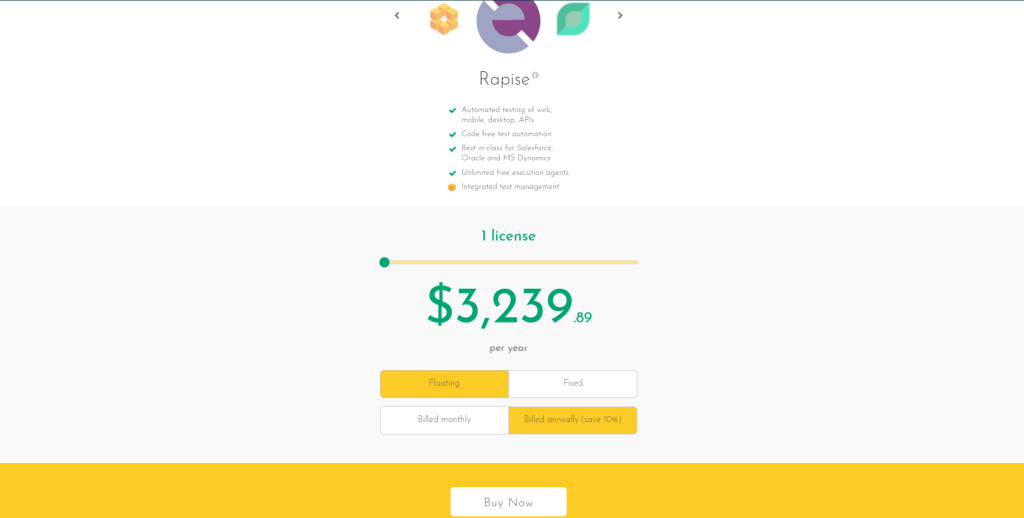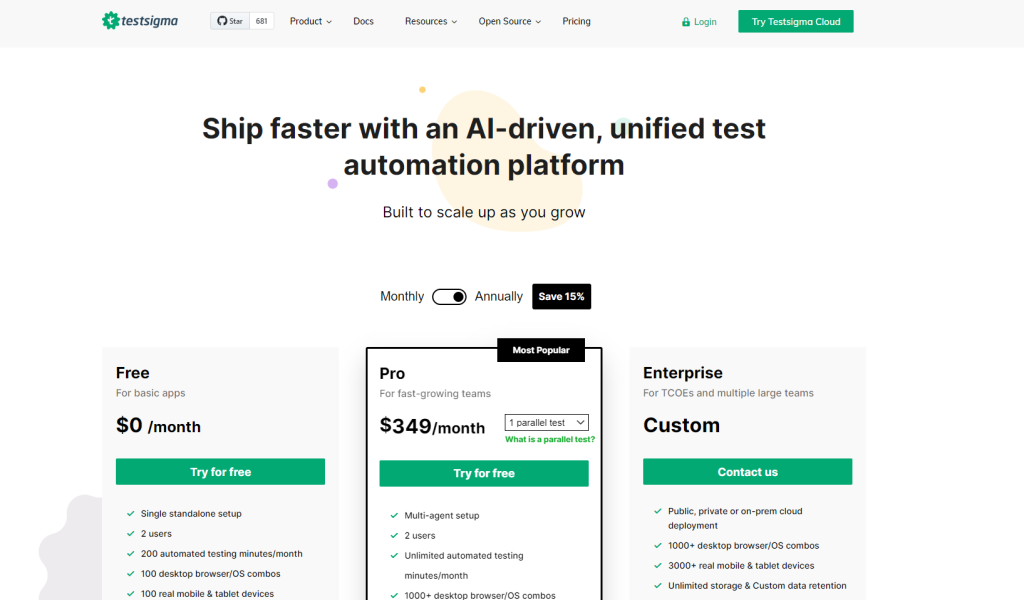Ever wondered if testing could be less about coding and more about creativity? Say hello to top 10 codeless automation testing tools – they’re like your trusty sidekick in the world of testing, making things simpler, quicker, and way more fun.
No more deciphering complex code – just easy, visual test creation that lets you focus on what really matters.
Take a chill journey with us as we dive into the world of codeless test automation. We’ll spill the beans on why this trend is making waves in the testing scene and how it can make your life easier.
From speedy test setups to smoother team collaborations, we’ll cover it all. Plus, we’ll break down the differences between codeless and traditional coded testing, giving you the scoop on which one could be your superhero sidekick.
So, let’s skip the code jumble and explore a breezy, codeless way of testing that’s sure to help you decide.
Comparison Chart Of Codeless Automation Testing Tools
Here’s a comparison table that includes key features, supported platforms, integration capabilities, AI/ML capabilities, as well as a rating for each of the 10 codeless automation testing tools:
Tools | Functionality | Supported Platform | Integration | Price | Ratings |
 | Design-first approach, API testing, versatile tech support | Web, Legacy, ERP (API Testing too) | Integrates with DevOps tools | Starting from $150/month | |
 | Web, API, mobile, desktop app testing | Web, API, Mobile, Desktop (Java, Groovy) | CI/CD pipelines | Starting from $167/month | |
 | AI-driven insights, easy test organization | Web, Mobile | – | Quoted on request | |
 | End-to-end testing, model-based automation | Web, Mobile, Desktop, API | Agile, DevOps, Jenkins, JIRA | Quoted on request | |
 | No-code automation, cross-browser testing | Web | – | Starting from $10/month | |
 | Real-device, emulator, simulator testing | Web, Mobile | CI/CD pipelines | Quoted on request | |
 | Enhanced efficiency | All | – | Quoted on request | |
 | User-friendly automation | All | CI/CD pipelines | Quoted on request | |
 | Versatile test automation | Web, Mobile, Desktop, API | Spira, JIRA | $4,999.99/user + $1,249.99 annual maintenance | |
 | AI-driven test creation | Web, Mobile, API | – | Starting from $349/month |
What Are the Codeless Automation Testing Tools?
Codeless automation testing tools are a game-changer in the world of software testing. They revolutionize the way testing is conducted by eliminating the need for coding skills.
These tools provide a user-friendly environment that empowers testers to create, execute, and analyze test cases without writing complex lines of code.
Imagine being able to automate tests without delving into programming languages like Java, Python, or C#. That’s precisely what codeless automation tools offer.
With their drag-and-drop interfaces and pre-built components, testers of all skill levels can create sophisticated test scenarios with ease.
But what exactly sets codeless automation testing tools apart? It’s their ability to make test automation accessible to everyone, from beginners to seasoned testers.
What you get is free codeless automation tools from the constraints of coding. Now you can focus more on test strategy, test design, and analyzing results.
Continuous testing is a crucial aspect of codeless automation tools. It involves the process of testing early, testing often, and testing comprehensively throughout the software development lifecycle.
Codeless tools seamlessly integrate with continuous integration and continuous delivery (CI/CD) pipelines, ensuring that each code change is thoroughly tested for bugs, errors, and compatibility issues.
By enabling testers to automate tests effortlessly, codeless automation tools enable faster feedback, quicker bug detection, and more efficient software development.
They bring testing closer to the development process, fostering collaboration between testers, developers, and other stakeholders.
In essence, codeless automation testing tools open the doors to efficient, accessible, and accurate test automation. They empower you to focus on what matters most – ensuring the software’s quality without the hurdles of coding complexity.
With these tools at your disposal, you can dive into testing with confidence, knowing that automation is within reach, no matter your coding prowess.
How Can QA Teams Utilize Codeless Test Automation?
Codeless test automation has transformed the landscape of software testing, making it more accessible and efficient. But how can Quality Assurance (QA) teams make the most out of these innovative tools?
Let’s explore how QA teams can harness the power of codeless test automation to enhance their testing processes.
Faster Test Creation
Codeless automation tools offer a visual, drag-and-drop interface that allows testers to create test scenarios quickly. QA teams can save time and effort by simply selecting and arranging the testing components, eliminating the need for writing extensive code.
Increased Test Coverage
Codeless tools empower QA teams to create a wide range of test cases effortlessly. This means more test scenarios can be covered, ensuring that different aspects of the software are thoroughly tested for bugs, errors, and vulnerabilities.
Easy Test Maintenance
When software undergoes changes, tests need to be updated accordingly. Codeless automation tools simplify this process. QA teams can easily modify test scenarios by rearranging blocks or components. This ensures that tests remain up-to-date with the latest changes.
Collaboration and Knowledge Sharing
QA teams can collaborate more effectively with developers and other stakeholders using codeless automation tools. The visual nature of these tools makes it easier to communicate test cases and results, promoting better understanding and collaboration among team members.
Bridging the Skill Gap
Not every QA team member may be proficient in coding. Codeless automation tools level the playing field by enabling testers of all skill levels to contribute to the automation process. This inclusivity enhances the overall team’s capabilities.
Early Bug Detection
QA teams can catch bugs and defects early in the development process using codeless automation.
By integrating these tools into the continuous integration and continuous delivery (CI/CD) pipeline, you can identify issues as soon as new code is added.
This will prevent the possibility of escalating into larger problems.
Iterative Testing
As the software evolves, QA teams can iteratively test and refine their test scenarios. Codeless automation tools facilitate this iterative approach, allowing you to quickly adapt tests to changing requirements and functionalities.
The Benefits of Using Codeless Test Automation Tools
Codeless test automation tools offer a wealth of advantages that make software testing faster, more efficient, and accessible to a wider range of professionals.
Let’s delve into the key benefits of using these tools and how they can transform the way Quality Assurance (QA) teams approach their testing processes.
Reduced Learning Curve
Learning to write code for test automation can be daunting, especially for testers who are not proficient in programming.
Codeless tools eliminate the need for coding skills, making it easier for QA team members to get started with test automation without the steep learning curve.
Enhanced Collaboration
Codeless testing tools promote better collaboration between QA teams, developers, and other stakeholders.
The visual nature of these tools makes it simpler to share test cases, results, and insights, fostering a more transparent and effective communication process.
Efficient Test Maintenance
When software evolves or changes, tests need to be updated accordingly. Codeless tools simplify test maintenance, enabling QA teams to make adjustments without rewriting extensive code. This agility ensures that tests remain accurate and effective.
Accessible to Non-Technical Testers
Not every QA team member is a coding expert. Codeless automation tools empower testers with varying technical backgrounds to contribute to the testing process. This inclusivity strengthens the overall team’s capabilities.
Cost and Time Savings
Traditional test automation often requires dedicated programming resources, which can be expensive and time-consuming. Codeless tools reduce the need for extensive coding, resulting in cost savings and quicker test creation.
Codeless test automation tools enable QA teams to test more efficiently, collaborate effectively, and achieve higher software quality.
By eliminating coding barriers and simplifying the testing process, these tools empower QA professionals to focus on delivering reliable and robust software products.
Top 10 Codeless Automation Testing Tools
Here’s all about the best no code test automation tools you could try:
1. AccelQ
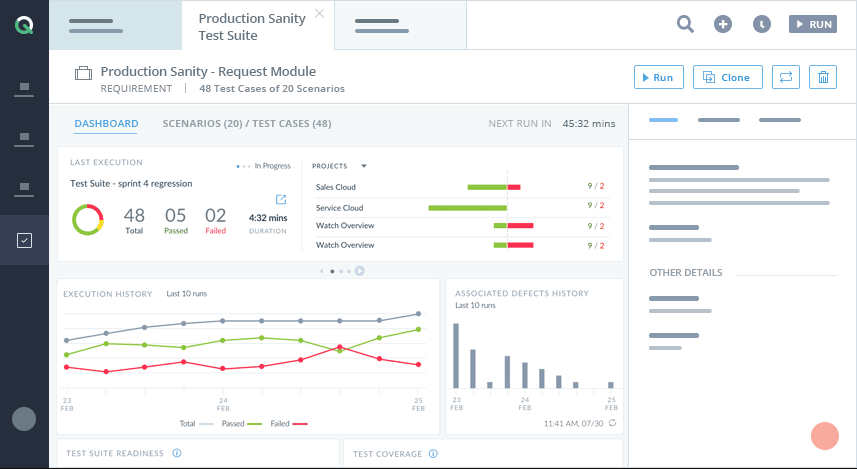
AccelQ is a pioneering codeless testing tools and test management tool that stands out for its emphasis on design and maintenance within the automation lifecycle.
This cloud-based solution offers a holistic approach to functional and API testing, making it a preferred choice for quality assurance teams.
AccelQ redefines codeless automation by prioritizing the design-first approach, allowing test cases to closely mirror business processes within applications.
Notably, it covers a wide range of technologies, from web to legacy platforms, and even offers comprehensive API testing capabilities.
The tool’s strengths lie in modularity, reusability, and its compatibility with various technology stacks, including ERP platforms like Salesforce, Pega, and SAP.
About AccelQ:
- Company Valuation: $200M to $500
- Employee Numbers: 51-200 employees
- Founding Team:Mahendra Alladi
Key Features of AccelQ:
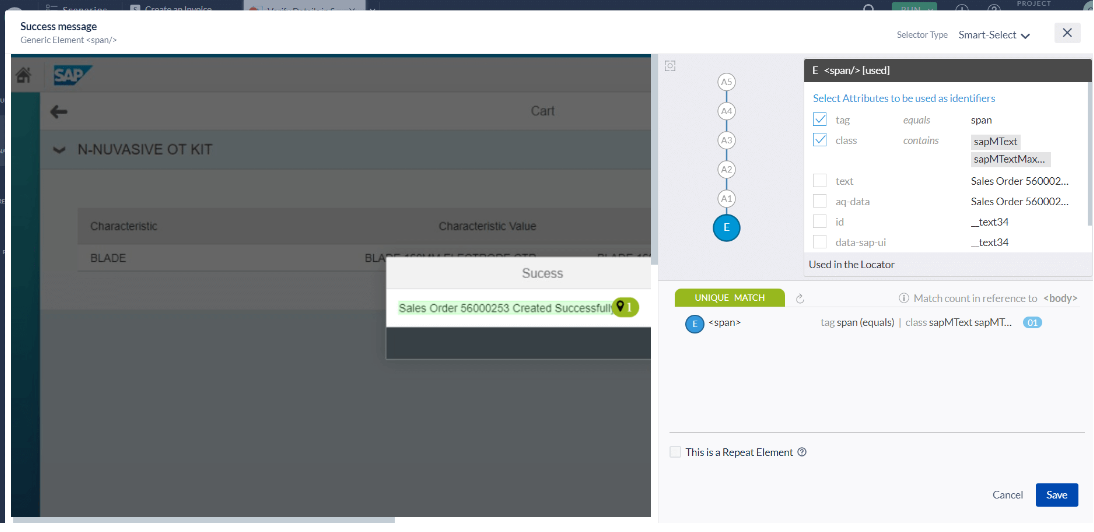
- Design-First Approach: Maps test development to business processes within applications.
- Comprehensive Technology Support: Covers web, legacy, and ERP platforms.
- API Testing: Extends codeless approach to API testing.
- Native Integration: Seamlessly integrates with leading DevOps tools.
Pros of Using AccelQ:
- Design-first concept promotes modularity and reusability.
- Suitable for web, legacy, and ERP testing.
- Granular reporting and defect creation.
Cons of Using AccelQ:
- Currently lacks mobile automation support.
- Basic implementation of performance metrics could enhance the tool further.
- The cost is much higher than the other tools
Pricing
Our review of Accelq:
ACCELQ brings innovation to codeless automation by emphasizing a design-first strategy that mirrors business processes. The tool’s cloud-based nature, coupled with its comprehensive functional and API testing capabilities, sets it apart in the market.
ACCELQ’s intuitive interface and versatility across different technology stacks make it a valuable asset for quality assurance teams. It impressively extends the codeless approach to API testing, enhancing its utility for end-to-end testing scenarios.
Moreover, its native integration with DevOps tools and seamless defect creation process streamlines the testing workflow.
Although mobile automation support and advanced performance metrics are areas for improvement, ACCELQ’s commitment to innovation and its design-first philosophy position it as a powerful contender in the test automation landscape.
The tool is a breath of fresh air in the test automation space, and its unique approach to design and maintenance ensures it remains a compelling choice for organizations aiming to enhance their testing efficiency.
2. Katalon Studio

Katalon Studio is a popular software testing tool used by many for its simplicity and effectiveness. It’s designed to help automate the testing process for web, API, mobile, and desktop applications, making testing faster and more efficient.
With Katalon Studio, you can create and manage test scripts without the need for extensive coding skills, thanks to its user-friendly interface and built-in features. It offers both record-and-playback and scripting options, accommodating both beginners and experienced testers.
Katalon Studio’s ability to run tests across various devices and platforms, along with its integrated test analytics, further enhances its appeal.
About Katalon Studio:
- Company Valuation: $27M
- Employee Numbers: 250-300
- Founding Team: Vu Lam,Uy Tran
Key Features of Katalon Studio:
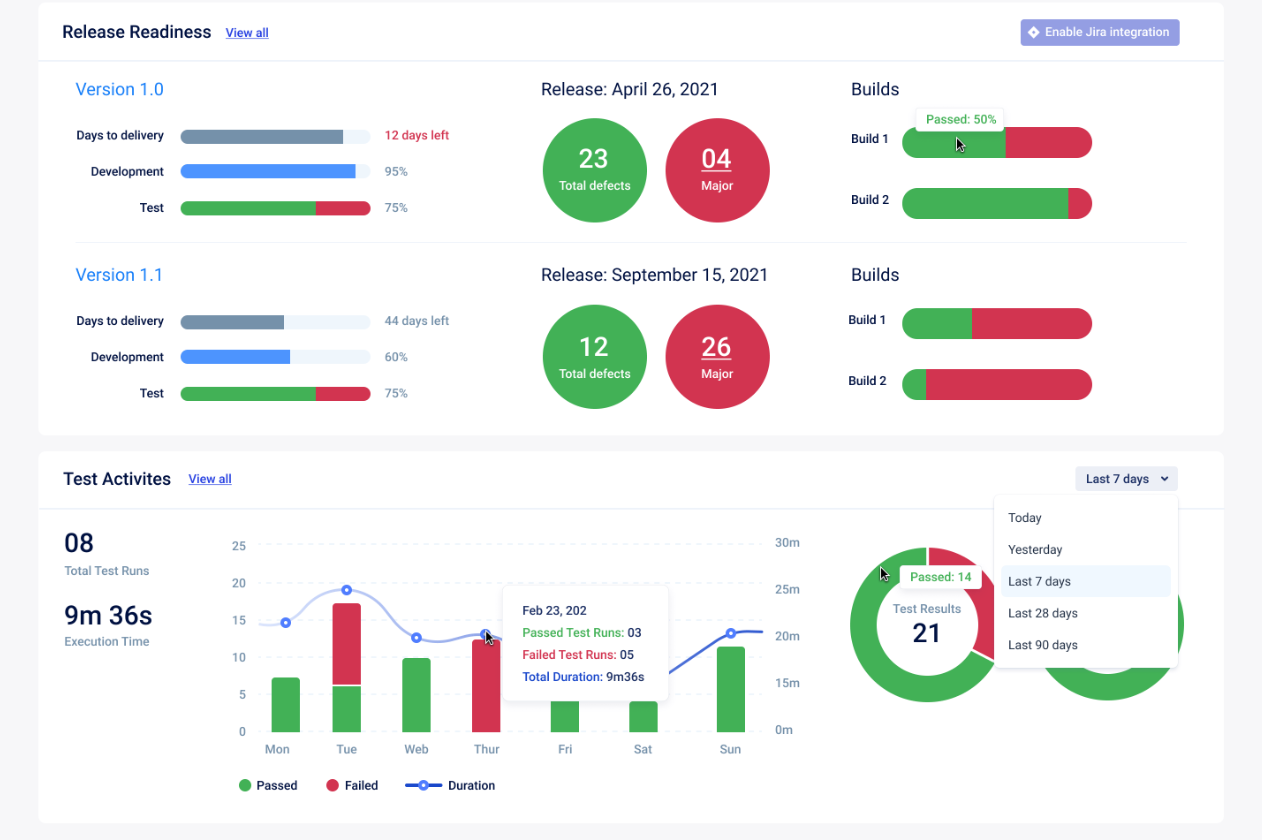
- User-friendly interface suitable for beginners.
- Supports web, API, mobile, and desktop application testing.
- Offers record-and-playback for easy test creation.
- Provides scripting options for customization.
- Runs tests across multiple devices and platforms.
- Integrated test analytics for actionable insights.
Pros of using Katalon Studio:
- Simplifies test automation without extensive coding.
- Versatile support for various testing types.
- Both record-and-playback and scripting options.
- Integrated test analytics for informed decisions.
- Runs tests across different devices and platforms.
Cons of using Katalon Studio:
- Limited language support (Java and Groovy).
- Performance issues reported by some users.
- Commercial product with subscription-based pricing.
Pricing
Our review of Katalon Studio:
Katalon Studio is a go-to choice for those seeking a user-friendly testing solution. Its ability to cater to both beginners and experienced testers is commendable.
With its record-and-playback and scripting capabilities, it strikes a balance between simplicity and customization. Running tests across diverse platforms and its integrated test analytics offer added value.
However, the limited language support and occasional performance concerns should be considered.
Katalon Studio’s subscription-based pricing might be a drawback for some, but the features and ease of use it provides make it a worthy contender in the testing tool landscape.
Katalon competitors for Codeless Automation
3. Testim
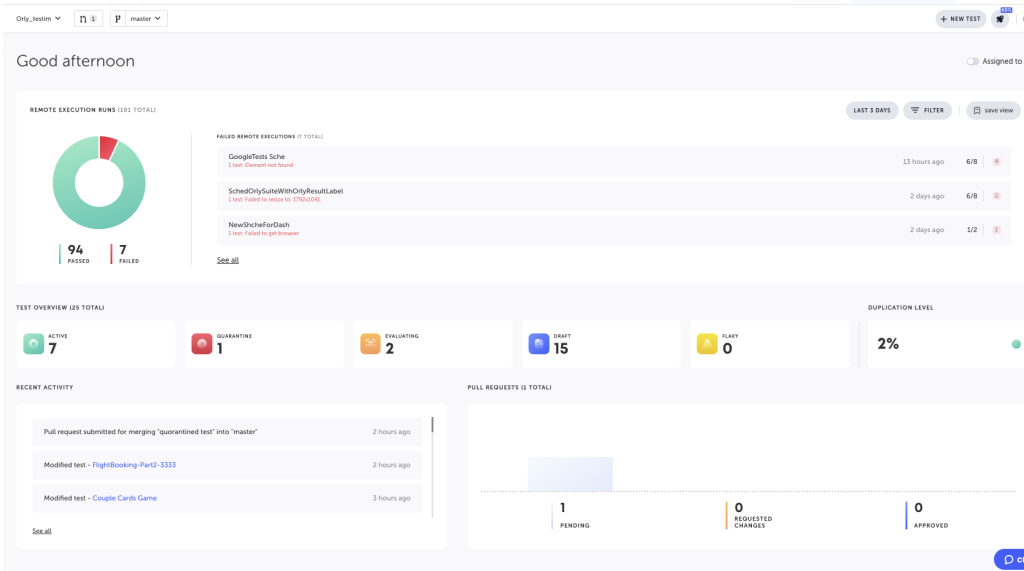
Testim is an automated testing solution designed to simplify and enhance the testing process through the power of artificial intelligence (AI) and machine learning (ML).
It’s a valuable tool for businesses aiming to create, execute, and maintain tests efficiently. With Testim, users can build, configure, and execute tests while benefiting from AI-driven insights and optimization.
The platform offers easy organization of tests using folders, labels, and plans, making it simple to manage tests based on different releases, user types, or features. Detailed reports provide valuable information on team productivity, recurring failures, and trends.
About Testim:
- Company Valuation:$10M to $50M
- Employee Numbers: 20-50
- Founding Team: Oren Rubin
Key Features of Testim:
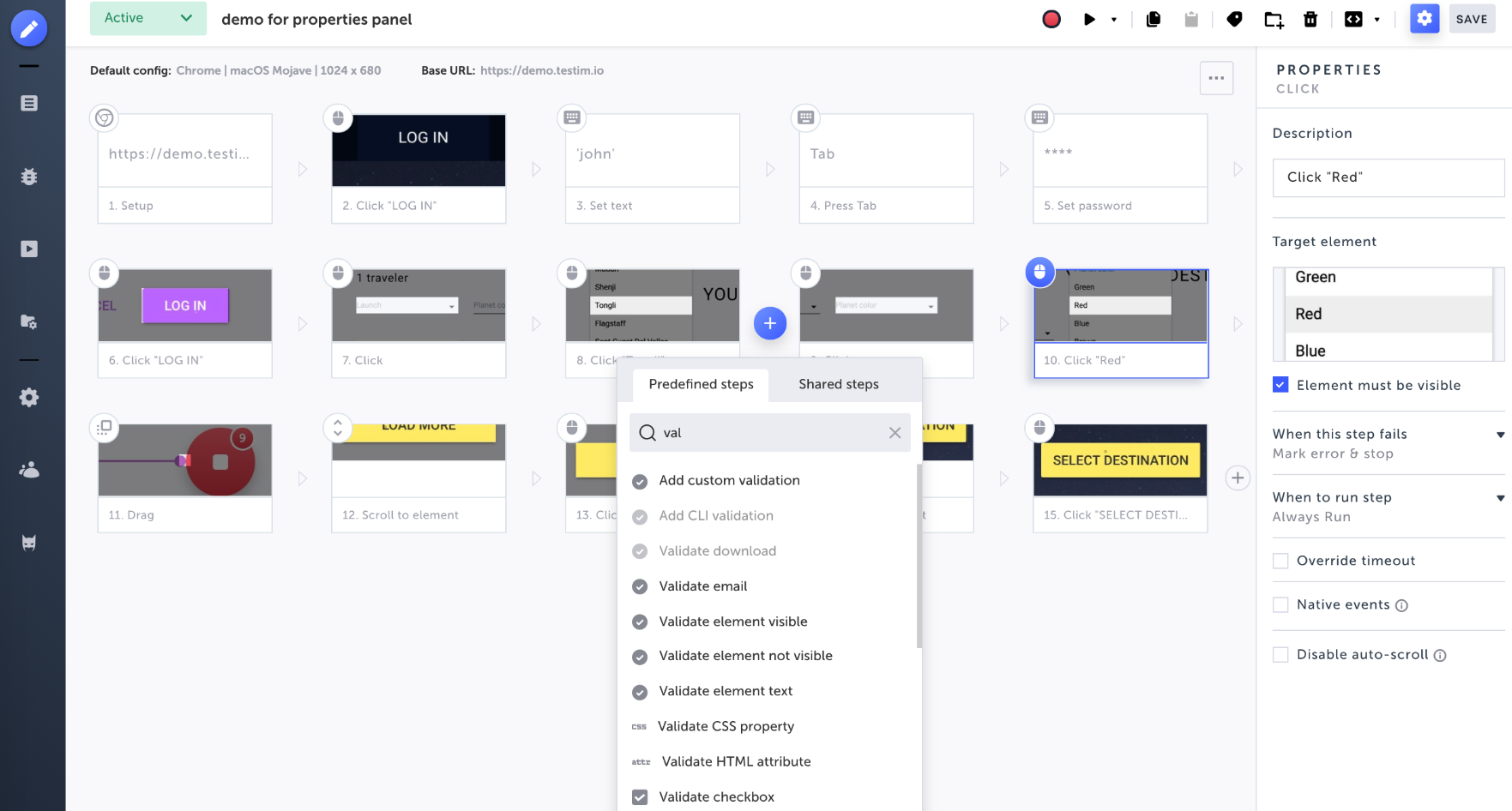
- Utilizes AI and ML for smarter testing.
- Simplifies test organization with folders and labels.
- Offers easy test creation, execution, and maintenance.
- Allows capturing complex authoring actions like iframe iterations and drag-and-drop.
- Provides the ability to export tests as code for customization.
- Offers insights into team productivity and testing trends.
Pros of using Testim:
- Harnesses AI and ML for efficient test creation and execution.
- Simplifies complex authoring actions.
- Enables easy customization through code export.
- Provides valuable insights into team productivity and trends.
Cons of using Testim:
- No email alerts are provided when a test fails in the grid until the suite passes again, which might delay issue identification.
- Scrolling within the app under test requires workarounds, suggesting potential usability difficulties.
- Missing integration with Azure DevOps at the test-case level
Pricing
Our review of Testim:
Testim emerges as a strong contender in the automated testing landscape, thanks to its integration of AI and ML technologies. The platform offers an efficient way to manage, execute, and maintain tests, with valuable insights to guide decision-making.
However, specific details regarding the company, its valuation, and employee numbers are missing, which limits our assessment of its overall standing in the market.
Nevertheless, the features mentioned highlight the potential value Testim can bring to businesses seeking to streamline their testing processes.
4. TOSCA MBTA
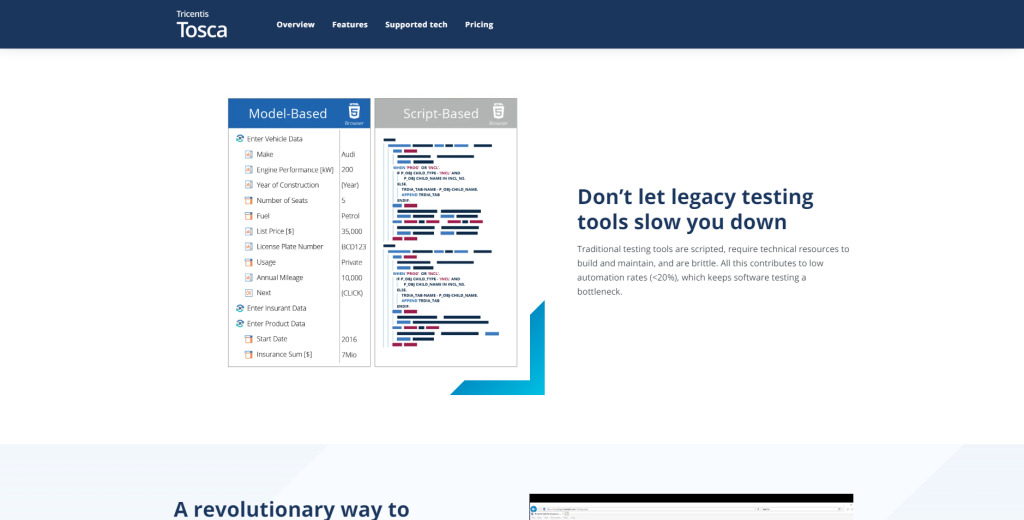
TOSCA Model-Based Test Automation (TOSCA MBTA) stands as a groundbreaking innovation in the world of software testing, proudly presented by Tricentis.
This powerful tool emerges as a game-changer, aiming to revolutionize and optimize the testing and automation workflows that span the entire software development lifecycle.
At its core, TOSCA MBTA is a catalyst for efficiency. It boasts the ability to seamlessly simplify, execute, and manage automated tests, effectively enhancing the precision and reliability of software testing.
Whether it’s web applications, desktop software, mobile platforms, or API integrations, TOSCA MBTA shines across the board, offering a versatile solution for testing diverse application types.
However, what truly sets TOSCA MBTA apart is its ingenious model-based approach. This unique methodology empowers testers to create intricate and comprehensive test cases with remarkable ease and efficiency.
No longer confined to intricate coding or convoluted scripting, testers can harness the power of visual models to articulate complex test scenarios, resulting in accurate and effective automated testing.
In a realm where testing plays a pivotal role in software quality, TOSCA MBTA emerges as a beacon of innovation.
With its commitment to streamlining testing processes and embracing a user-centric model-based approach, it’s no exaggeration to say that TOSCA MBTA redefines the possibilities of software testing
About TOSCA MBTA:
- Company Valuation: Raised $172M over 3 rounds
- Employee Numbers: 50-100
- Founding Team: Franz Fuchsberger, Wolfgang Platz
Key Features of TOSCA MBTA:
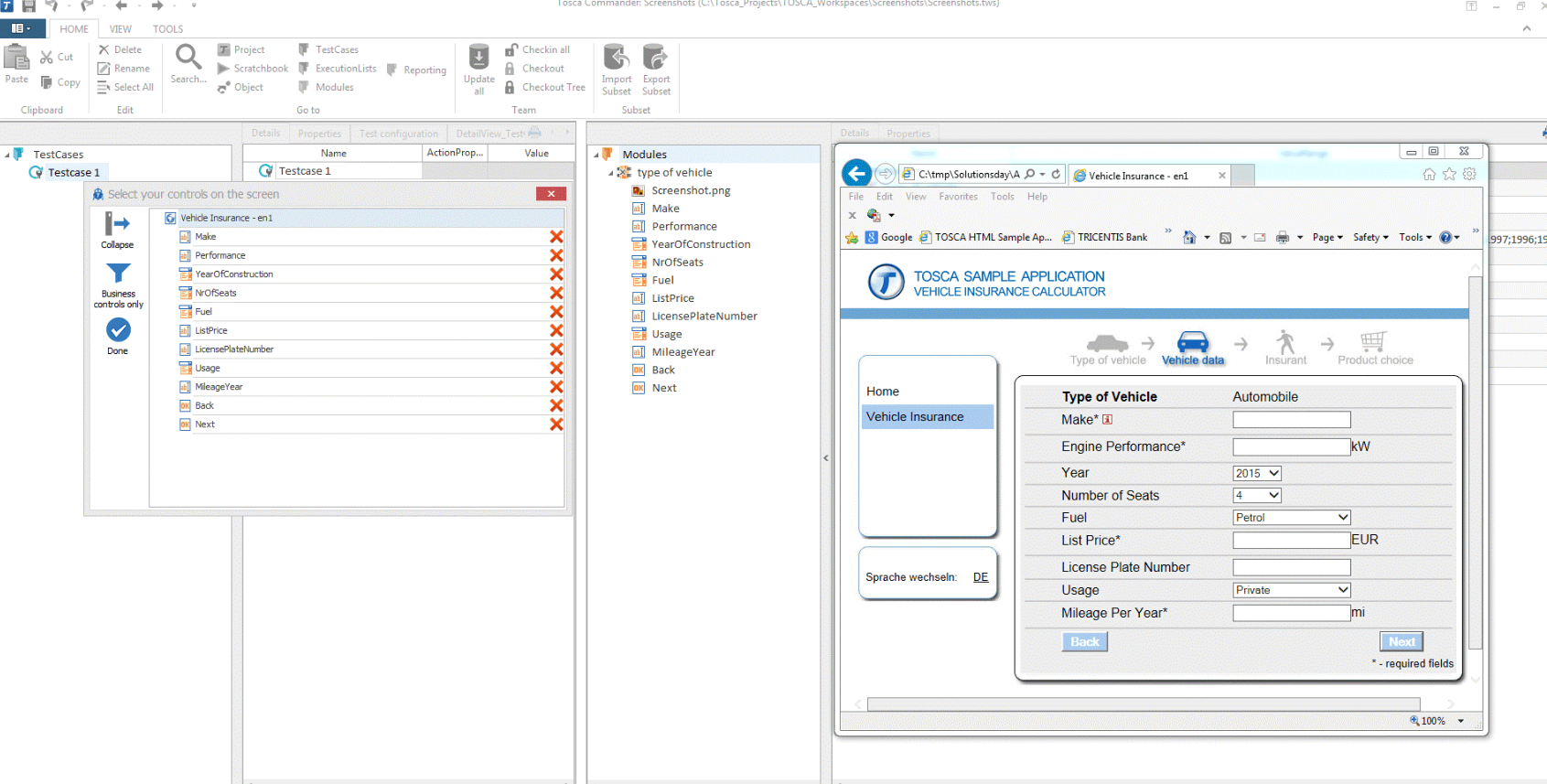
- Supports end-to-end functional testing for web, mobile, desktop, and API applications.
- Utilizes model-based test automation methodology for intuitive test case creation.
- Integrates with Agile and DevOps methodologies, supporting various platforms like Java, .NET, SAP, Salesforce, etc.
- Generates automated scripts using AI technology, reducing manual effort.
- Offers risk-based testing to prioritize critical tests and optimize resource utilization.
- Seamless integration with tools like JIRA, Jenkins, and Selenium WebDriver.
- Comprehensive reporting for test insights and defect identification.
Pros of using TOSCA MBTA:
- Efficient end-to-end testing across various application types.
- Model-based approach simplifies test case creation.
- Integration with popular tools streamlines workflows.
- AI-powered script generation saves time and effort.
Cons of using TOSCA MBTA:
- There is room for improvement in the AI-based insights offered by the tool.
- No cloud-based access that can be used across teams.
Pricing
Our review of TOSCA MBTA:
TOSCA Model-Based Test Automation (TOSCA MBTA) emerges as a robust solution for software testing and automation needs.
Its model-based approach, integration capabilities, and AI-powered features make it a valuable addition to testing processes.
While specific details about the company, valuation, and employee numbers are absent, the tool’s key features and benefits highlight its potential to enhance testing efficiency and maintain software quality.
TOSCA MBTA’s intuitive interface and integration with various tools position it well for modern software development teams seeking streamlined testing practices.
5. Cloud QA

CloudQA is a game-changing solution that empowers users to generate and automate tests without requiring a single line of code.
This innovative tool is designed to simplify the testing process and make it accessible to a wide range of users, including those without technical expertise.
By offering an easy-to-use interface, CloudQA enables users to build reusable cross-browser test cases for tasks like regression testing and synthetic monitoring.
It eliminates the need for complex coding, making it an excellent choice for teams seeking a streamlined testing solution.
With CloudQA, you can ensure the quality and performance of your web applications without the hurdles of traditional coding-based testing.
About CloudQA:
- Company Valuation: Funding raised $487M
- Employee Numbers: 50 to 70
- Founding Team: Sumant Mehta, Arun Kulkarni
Key Features of CloudQA:
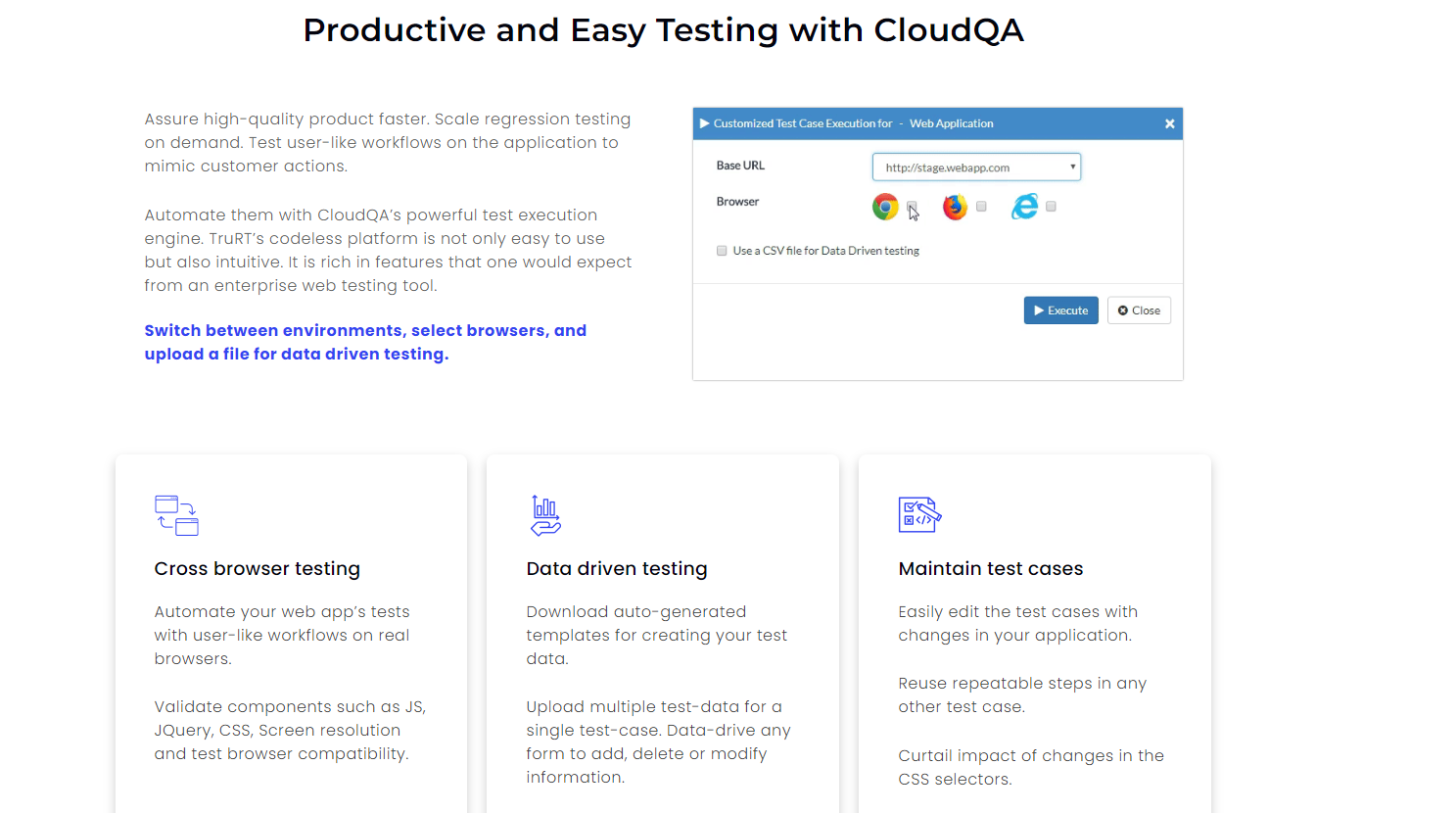
- No-code automation: Build and run automated tests without coding skills.
- Cross-browser testing: Create reusable test cases for various browsers.
- Simplified UI: Intuitive interface for easy test case creation and management.
Pros of Using CloudQA:
- No coding required, making it user-friendly for non-technical stakeholders.
- Efficient test case creation and execution.
- Ensures consistent performance across different browsers.
Cons of Using CloudQA:
- Some users might find the no-code approach limiting for complex scenarios.
- Execution might slow down for lengthier test cases.
Pricing
Our review of CloudQA:
CloudQA is a remarkable no-code automation tool that has the potential to transform the way testing is approached. Its standout feature is its user-friendly approach, allowing individuals without coding expertise to create and run automated tests effortlessly.
This accessibility opens up a world of possibilities for non-technical stakeholders to actively participate in the testing process.
One of the most significant advantages of CloudQA is its ability to accelerate testing processes. It has simplified UI and cross-browser testing capabilities.
Thus, it becomes a time-saving solution for teams seeking quick and efficient test case creation. The integration of a web capture feature allows users to easily record actions directly in the browser, streamlining the process even further.
However, it’s worth noting that while CloudQA is excellent for scenarios where traditional coding might not be necessary, it might fall short when it comes to highly customized testing needs.
If you are looking for intricate testing scenarios, you might find the tool’s capabilities somewhat limited.
6. Perfecto
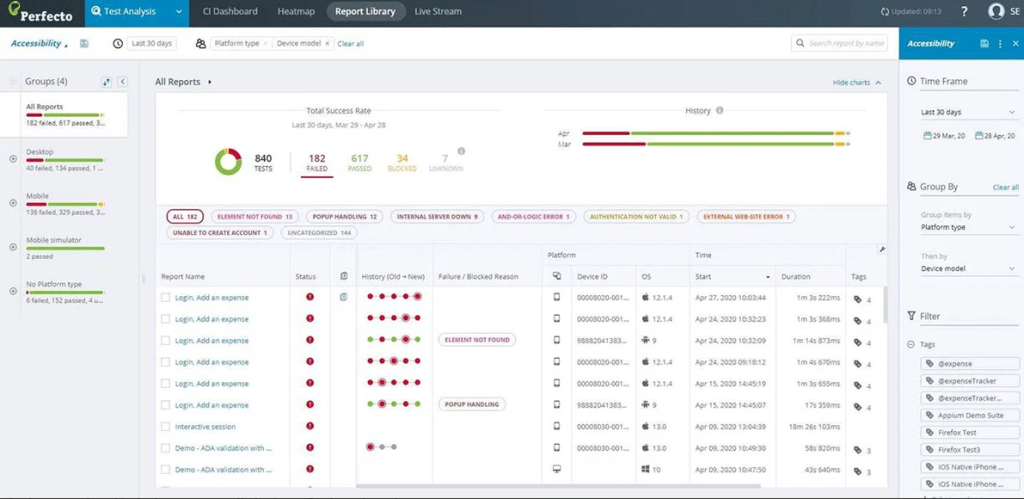
Perfecto stands as a premier choice for organizations seeking flawless mobile and web testing solutions. It offers a comprehensive suite of tools that ensure top-tier digital experiences across various devices and browsers.
Perfecto’s proficiency lies in its ability to provide real-device testing, covering a wide range of scenarios to identify and rectify potential issues before they impact users.
Perfecto empowers users to test applications on real devices, emulators, and simulators, offering comprehensive coverage.
About Perfecto:
- Company Valuation: Funding $126M in 8 rounds
- Employee Numbers: 100-200
- Founding Team: Eran Yaniv, Yoram Mizrach
Key Features of Perfecto:
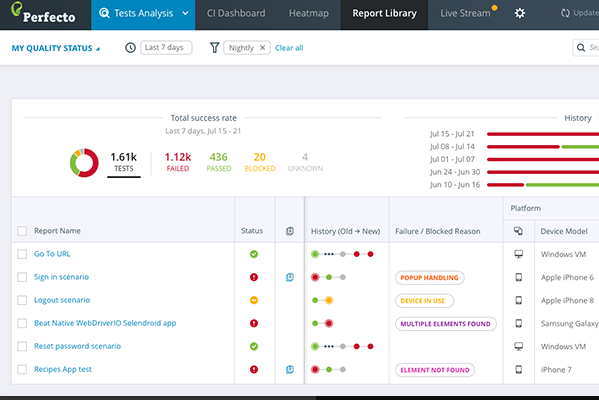
- Real-device testing
- Emulator and simulator testing
- Continuous testing integration
- Performance insights
- Comprehensive device and browser coverage
Pros of Using Perfecto:
- Wide coverage across devices and browsers
- Seamless integration with CI/CD pipelines
- In-depth insights for performance optimization
Cons of Using Perfecto:
- Potential learning curve for beginners
- Advanced features might require adequate training
Pricing
Our review Perfecto:
Perfecto redefines mobile and web testing, ensuring top-notch digital experiences. Its real-device testing, integration with CI/CD pipelines, and performance insights elevate its value.
While beginners might face a learning curve, the platform’s capabilities make it an indispensable asset for organizations committed to delivering flawless digital interactions.
You will enjoy the seamless integration with CI/CD pipelines to deliver continuous automated testing throughout the development cycle.
Provides in-depth insights into application performance, aiding in identifying and addressing bottlenecks.
7. Curiosity Software
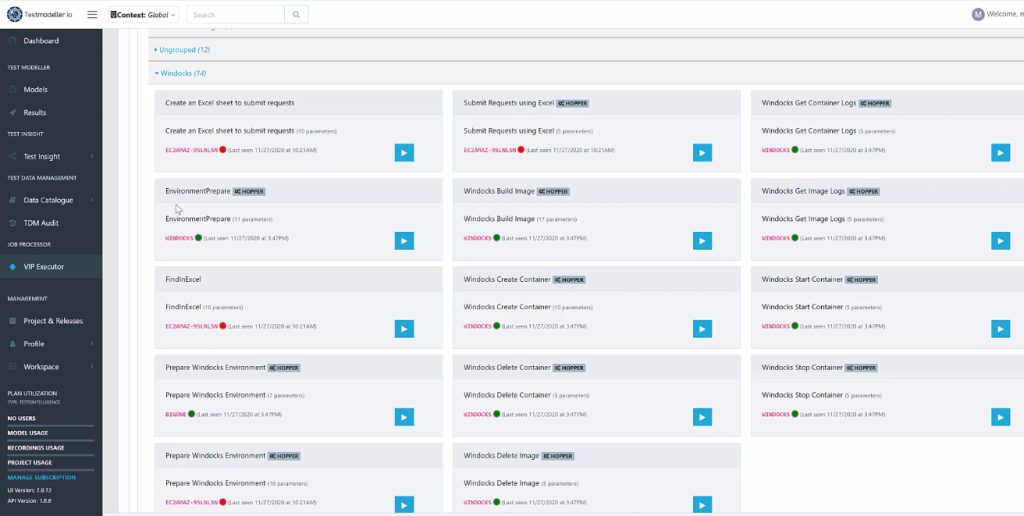
Curiosity Software presents a revolutionary shortcut and sorting application, redefining how PC users manage their digital world.
This dynamic tool serves as a centralized knowledge base, seamlessly organizing files, applications, calendar events, workspaces, and more into an instantly accessible, unified platform.
The brilliance of Curiosity lies in its ability to integrate diverse data sources, from local files to cloud storage, calendars, emails, and even web searches.
With support for apps like Dropbox, Teams, GitHub, and Asana, users experience instant results for every query, all displayed on a single dashboard.
This application goes beyond mere convenience, offering a comprehensive overview of valuable information. Curiosity can navigate meetings, explore the web, and search through vast data repositories using custom key combinations.
The search queries provide filtering and sorting options, ensuring users find relevant data efficiently.
Freelancers, small businesses, mid-sized enterprises, and large corporations all benefit from Curiosity’s efficiency-enhancing capabilities. Its support for various platforms, including web, Android, and iPhone/iPad, ensures seamless accessibility.
Customer support options such as email, phone, chat, and knowledge base contribute to a user-friendly experience.
Curiosity Software revolutionizes digital organization, offering a new way to manage files, communications, and data sources effortlessly. Its intuitive interface and extensive integration capabilities make it a must-have for anyone seeking to optimize their digital workflow.
About Curiosity Software:
- Employee Numbers: 11-50
- Founding Team: Huw Price; James Walker; Shashank Mishra
Key Features of Curiosity Software:
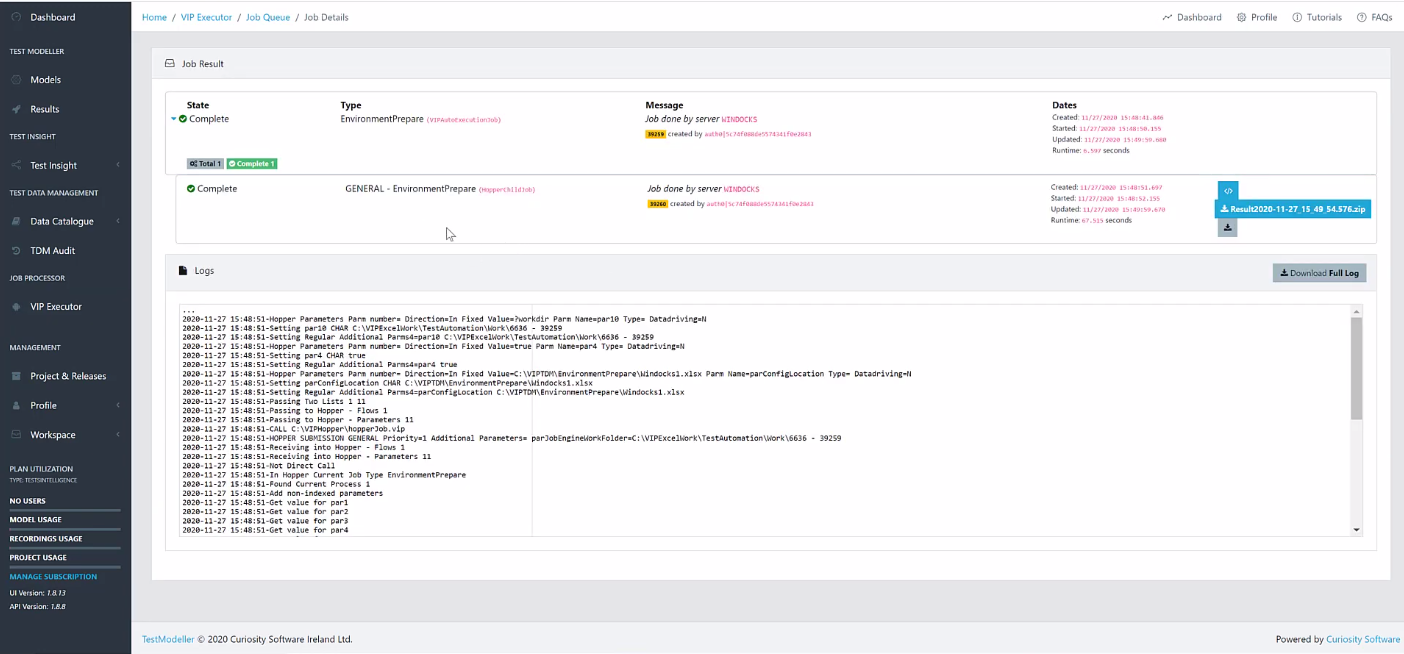
- Offers a versatile platform to transform software testing processes.
- Focuses on enhancing testing efficiency and collaboration among teams.
- Provides comprehensive features to cater to various testing requirements.
Pros of using Curiosity Software:
- Enhances testing efficiency and optimizes resource utilization.
- Improves collaboration and communication among development teams.
- Offers a versatile platform to accommodate diverse testing needs.
Cons of using Curiosity Software:
- Learning curve during initial use.
- Integration complexity for non-technical users.
- Possible compatibility issues with integrated apps.
- Dependency on external services’ uptime and changes.
- Curiosity Software’s comprehensive interface might overwhelm new users.
Pricing
Our review of Curiosity Software
The stands out as a promising tool for organizations seeking to elevate their software testing and quality assurance practices.
While detailed information about the company, valuation, and employee numbers is unavailable, the tool’s focus on enhancing efficiency, collaboration, and catering to diverse testing requirements is evident.
With its versatile features, Curiosity Software aims to provide a holistic solution to streamline the software development lifecycle. However, without specific pros and cons mentioned in the provided text, a comprehensive assessment of the tool’s strengths and weaknesses is challenging.
Overall, Curiosity Software’s focus on transforming testing processes is likely to resonate with businesses aiming to optimize their testing practices and deliver high-quality software products.
8. Leapwork

Leapwork is a revolutionary automation platform that empowers businesses to achieve rapid and efficient automation of various processes.
The tool is renowned for its user-friendly approach to automation, enabling users to automate complex tasks without the need for extensive coding knowledge.
Leapwork is designed to accelerate digital transformation by simplifying automation workflows, making it an appealing choice for organizations seeking to optimize their operations.
About Leapwork:
- Company Valuation: Revenue $60.9M/ Funding $72M
- Employee Numbers: 250-350
- Founding Team: Claus Rosenkrantz Tophol; Christian Brink Frederiksen
Key Features of Leapwork:
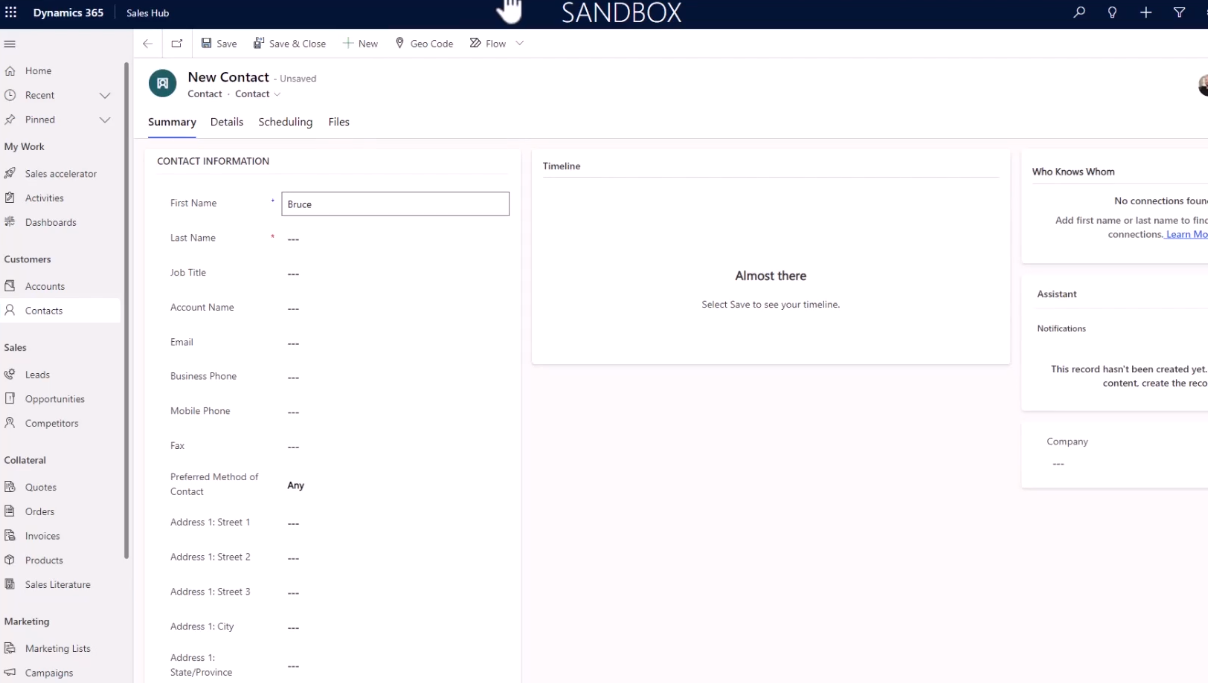
- Offers a user-friendly automation platform for diverse processes.
- Simplifies automation workflows without requiring extensive coding.
- Aims to accelerate digital transformation through efficient automation.
Pros of using Leapwork:
- User-friendly interface enables non-technical users to create automation.
- Accelerates automation initiatives and digital transformation efforts.
- Streamlines processes, reducing manual effort and human error.
Cons of using Leapwork:
- Difficulty in getting the graphics to work effectively when creating large scripts or sequences.
- Disappointment over the need for a graphical interface to execute scripts, which might restrict flexibility.
Pricing
Our review of Leapwork:
Leapwork emerges as an impactful automation platform with its focus on user-friendly automation and acceleration of digital transformation.
Although detailed information about the company’s valuation, employee numbers, and founding team is absent, Leapwork’s strengths lie in its ability to simplify automation workflows for a wide range of processes.
The tool’s accessibility to non-technical users is a significant advantage, as it allows organizations to harness automation without extensive coding expertise.
Leapwork’s potential to streamline processes, reduce manual effort, and enhance efficiency aligns well with the demands of modern businesses.
While specific pros and cons are not provided in the text, Leapwork’s emphasis on accessible automation and digital transformation makes it a promising solution for enterprises looking to optimize their operations through automation.
9. Rapise
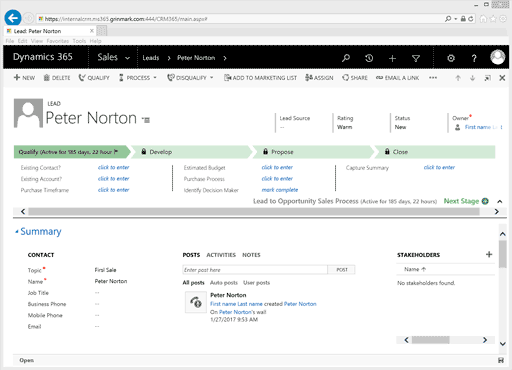
Rapise is an exceptional test automation and software quality assurance platform, designed to elevate software testing processes for organizations of all scales.
What sets Rapise apart is its remarkable versatility, capable of revolutionizing testing workflows across a spectrum of technologies, spanning web, mobile, and desktop applications.
At its core, Rapise empowers businesses to amplify their testing endeavors by providing a comprehensive suite of tools and features. Its robust automation capabilities simplify the creation, execution, and maintenance of test scripts, ensuring efficiency and accuracy.
This, in turn, leads to enhanced software quality and faster development cycles.
One of Rapise’s standout features is its adaptability to diverse application types. Whether it’s testing web interfaces, mobile apps, or desktop software, Rapise seamlessly integrates with each, enabling consistent and thorough testing.
This adaptability translates into significant time savings, as testing teams can work within a unified environment instead of juggling multiple tools.
Furthermore, Rapise’s intuitive interface and user-friendly scripting language facilitate collaboration between technical and non-technical team members.
Testers with varying expertise levels can contribute effectively, resulting in a more holistic and efficient testing process.
About Rapise:
- Company Valuation: $751M funding (Owned by Infectra)
- Employee Numbers: 51-200
- Founding Team: Adam Sandman; Denis Markovtsev
Key Features of Rapise:
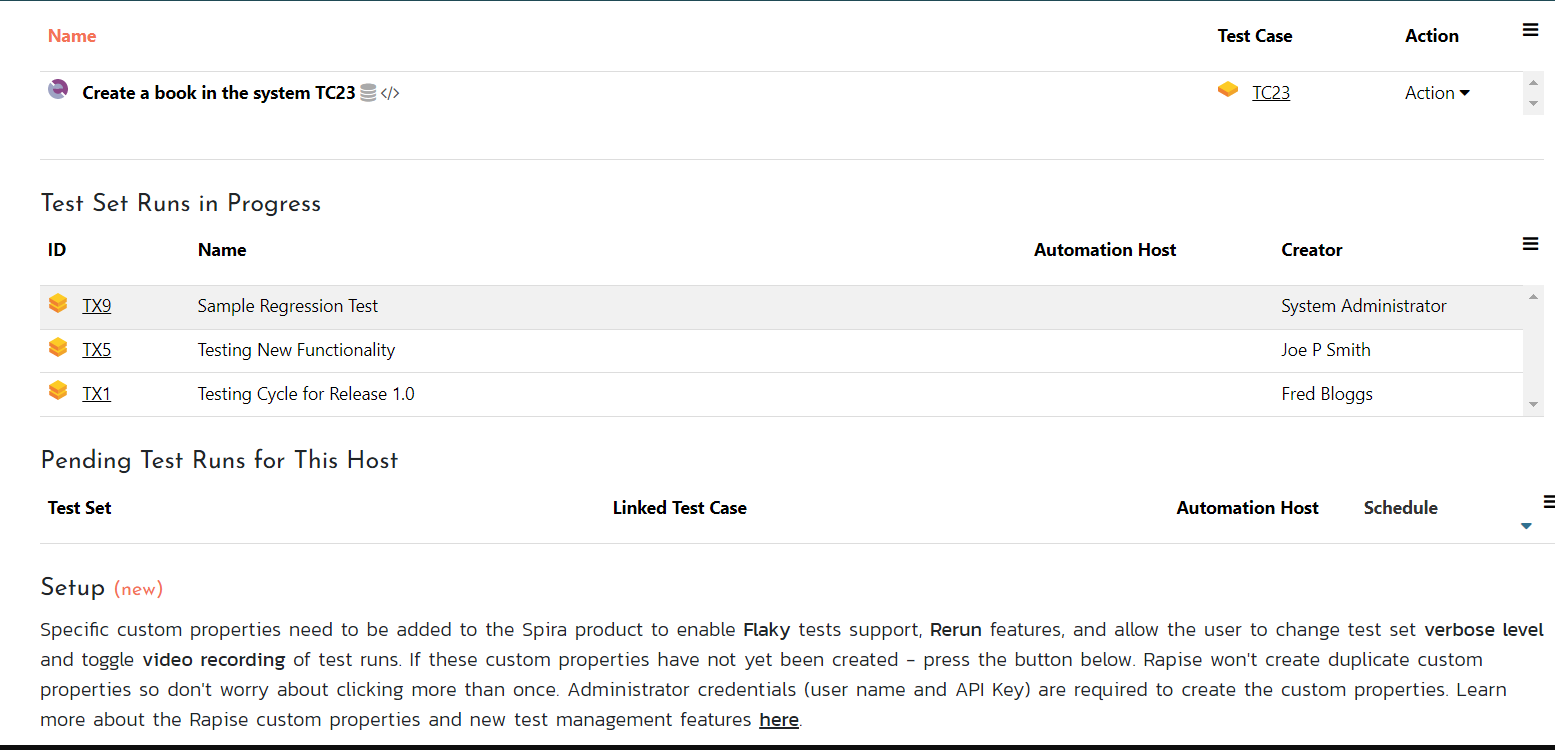
- Offers a comprehensive test automation and quality assurance platform.
- Supports automation of tests across diverse technologies, including web and mobile applications.
Pros of using Rapise:
- Provides flexibility to automate tests for different types of applications.
- Aims to enhance software quality and streamline testing processes.
- Offers a versatile solution for software testing and quality assurance.
Cons of using Rapise:
- Occasional integration issues with Spira and Rapise for automated tests, though rare.
- Satisfactory performance, meeting requirements, with minimal drawbacks.
- Requires in-depth knowledge of JavaScript for efficient usage.
- No direct integration with JIRA for seamless workflow.
Pricing
Our review of Rapise:
Rapise stands as a flexible and comprehensive test automation platform, catering to the diverse needs of organizations aiming to improve their software testing processes.
Rapise’s focus on automation across various technologies, including web and mobile applications, showcases its versatility.
The tool’s capability to enhance software quality and streamline testing processes aligns well with the goals of modern businesses seeking to optimize their development cycles.
Rapise’s potential to offer flexibility and comprehensive solutions for software testing and quality assurance makes it a noteworthy consideration for organizations looking to achieve higher efficiency and accuracy in their testing efforts.
10. Testsigma
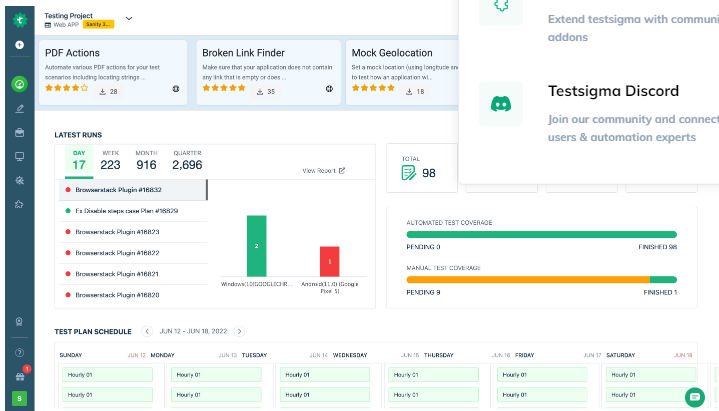
Testsigma emerges as a trailblazing test automation platform, meticulously crafted to orchestrate a seamless transformation of software testing processes within organizations.
What truly sets Testsigma apart is its innovative and forward-thinking AI-driven approach, which fundamentally revolutionizes the landscape of test creation, execution, and maintenance.
The crux of Testsigma’s allure lies in its ability to simplify the complex. With its AI-powered capabilities, the traditionally intricate process of test case creation and execution is streamlined to a remarkable degree.
This translates to increased efficiency, reduced human error, and accelerated testing cycles. Testsigma’s unique model-based testing approach empowers testers to create and maintain test cases with unprecedented ease and efficiency.
Moreover, Testsigma’s versatility shines through its extensive application coverage. From web and desktop to mobile and API testing, the platform seamlessly caters to diverse testing needs across various domains.
This adaptability ensures that no matter the application type, Testsigma remains a steadfast tool for optimizing testing efforts.
By leveraging Testsigma, organizations not only harness the power of AI to transform their testing procedures but also elevate their software quality.
The platform’s inherent reliability and automation capabilities facilitate thorough testing, enabling businesses to confidently deliver high-quality applications to their users.
About Testsigma:
- Company Valuation: Funding $4.6M
- Employee Numbers: 100-150
- Founding Team: Pratheep Velicherla. Co-Founder ; 2. Vikram Chaitanya.
Key Features of Testsigma:
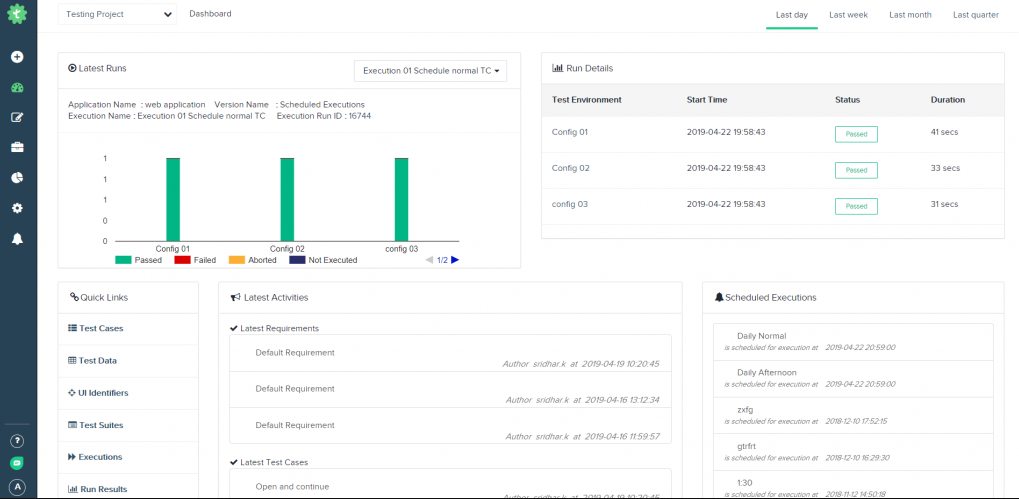
- Leverages AI to enable easy test creation and maintenance.
- Supports automated testing across web, mobile, and API applications.
Pros of using Testsigma:
- Harnesses AI for efficient test case creation and maintenance.
- Offers flexibility for testing web, mobile, and API applications.
- Aims to enhance test efficiency and software quality.
Cons of using Testsigma:
- Performance should be improved, especially after entering more NLPs (Natural Language Processing), as it takes more time to add NLPs after reaching around 200-300 steps.
- Application performance needs improvement for better usability and efficiency.
Pricing
Our review of Testsigma:
Testsigma distinguishes itself with an AI-driven approach that streamlines test creation and maintenance, catering to organizations looking for efficient and effective testing solutions.
Although details about the company’s valuation, employee numbers, and founding team are not available in the text, Testsigma’s emphasis on AI-powered test automation showcases its commitment to optimizing the testing process.
By supporting automation across web, mobile, and API applications, Testsigma offers a versatile solution for a range of testing needs.
While specific pros and cons are not outlined in the text, Testsigma’s focus on AI-driven efficiency and software quality enhancement makes it a noteworthy choice for businesses aiming to achieve comprehensive and streamlined software testing processes
Frequently Asked Questions – FAQs
What are codeless test automation tools?
Codeless test automation tools are software platforms that allow users to create and execute automated tests without requiring manual coding.
These tools use visual interfaces, drag-and-drop actions, and pre-built components to design and run tests, making it easier for non-technical users to automate testing processes.
Why codeless test automation?
Codeless test automation offers several advantages, including faster test creation, reduced reliance on coding skills, and increased collaboration between technical and non-technical team members.
It enables efficient testing by allowing testers to focus on test scenarios and functionality rather than writing code.
What is the difference between codeless and coded test automation?
Codeless test automation involves creating automated tests using visual interfaces and pre-built components, while coded test automation requires writing scripts in programming languages like Java or Python.
Codeless tools are more user-friendly and suitable for testers without coding expertise, whereas coded automation provides greater flexibility and customization for complex testing scenarios.
Conclusion
The keyword here is accessibility. Codeless automation testing tools offer a user-friendly environment, allowing testers to effortlessly create, execute, and analyze test cases.
No longer is coding expertise a prerequisite; instead, a simple drag-and-drop interface empowers testers of various skill levels.
In this comprehensive review of the top 10 codeless automation testing tools, we explored the unique features and benefits that each tool brings to the table.
Notably, tools like AccelQ have innovated with a design-first approach, bridging the gap between business processes and test cases. Katalon Studio’s simplicity and versatility shine through in its support for various testing types.
Leapwork caught our attention with its focus on accelerating digital transformation through streamlined automation workflows. And then there’s Testsigma, utilizing the power of AI to enhance test case creation and maintenance, aiming to optimize testing processes.
However, Perfecto steals the spotlight with its comprehensive suite of tools that ensure top-tier mobile and web testing experiences.
The real-device testing and cross-browser capabilities of Perfecto position it as a go-to choice for organizations prioritizing flawless digital interactions.
In a nutshell, the best no code test automation tools, including AccelQ, Katalon Studio, Leapwork, Testsigma, and Perfecto, among others, have made testing accessible, efficient, and collaborative.
- Namelix: AI Business Name Generator Explained Simply - May 20, 2025
- Best Mobile Speaker Cleaner Tools and Safe Cleaning Tips - May 1, 2025
- How to Convert PDF to Excel Easily (No Signup Needed) - April 13, 2025
